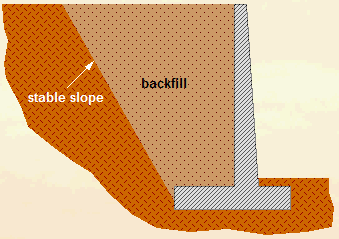
Free-standing retaining walls are constructed in an open excavation and the retained soil is backfilled after construction. Generally free-standing walls are only economically viable on sites where there is sufficient space to compact the sides of the excavation to stable slope.
Isolated free-standing walls, as shown in figure, are used to retain soil at changes in level in landscaped sites and for cuttings and embankments. In buildings, free-standing walls are usually temporarily cantilevers, which are later propped by the adjoining floors. Common use of free-standing retaining walls is at highway underpasses. Free-standing retaining walls must provide their own stability against overturning and sliding.
Fig: Free standing retaining wall
Stability against overturning is achieved when![]()
Stability against sliding is achieved when![]()
This is achieved in different ways and gives rise to various types of retaining wall:
- Gravity retaining wall
- Cantilever retaining wall
- Counterfort retaining wall
Free-standing gravity retaining walls
Free-standing gravity retaining walls rely on the self weight of the mass concrete for stability.
Providing toe in this retaining wall increases both the resistance to overturning and sliding. Because of the large section flexure and shear are not critical. The design is concerned mainly with keeping the resultant force within the middle third of the base to prevent the base from losing contact with the soil at the heel.
 Fig: Free Standing Gravity Retaining Wall
Fig: Free Standing Gravity Retaining Wall
With such large volumes of concrete great care must be taken to reduce hydration temperatures by mix design, construction procedures and curing techniques. It is common practice to provide reinforcement mesh in the wall faces to control thermal and shrinkage cracking.
Generally free-standing gravity retaining walls are economical for retaining low walls, possibly upto 3 meters.
Free-standing cantilever retaining wall:
Cantilever walls rely on the weight of the fill on the heel and the self weight of the wall for stability. The vertical stem is supported by a footing or base slab. The stem, toe and heel are each defined as cantilever slabs.
 Fig: Free-standing cantilever retaining wall
Fig: Free-standing cantilever retaining wall
The bearing pressure is less under the heel than under the toe. On the heel the downward pressure of the fill is greater than upward bearing pressure. On the toe, the upward bearing pressure is greater than any downward pressure.
Like the gravity wall, the line of the resultant force should be within the middle third of the base to prevent the base from losing contact with the soil at the heel.
 Fig:key of gravity cantilever retaining wall to prevent sliding
Fig:key of gravity cantilever retaining wall to prevent sliding
If the sliding resistance is insufficient a key is added beneath the base in a position to suit the design. Generally cantilever walls are economical for heights from 3 to 6 meters.
Free-standing Counterfort retaining wall:
Counterfort retaining walls are used for heights between 6 and 12 meters, where a cantilever wall is uneconomic. Like cantilever walls they rely on the weight of the fill on the heel and the considerable self weight of the wall for stability.
 Fig:Free-standing counterfort retaining wall
Fig:Free-standing counterfort retaining wall
The stem and heel are joined at regular intervals by counterforts or bracing walls. Counterforts act as tension ties and completely change the cantilever action of the stem and the heel slabs, thus
- The heel slab is supported on 3 sides
- The stem is considered to span horizontally between the counterforts.
Typically the counter fort is pitched at 70 degree which can make the base too short to provide sufficient sliding resistance, so a key is added.

